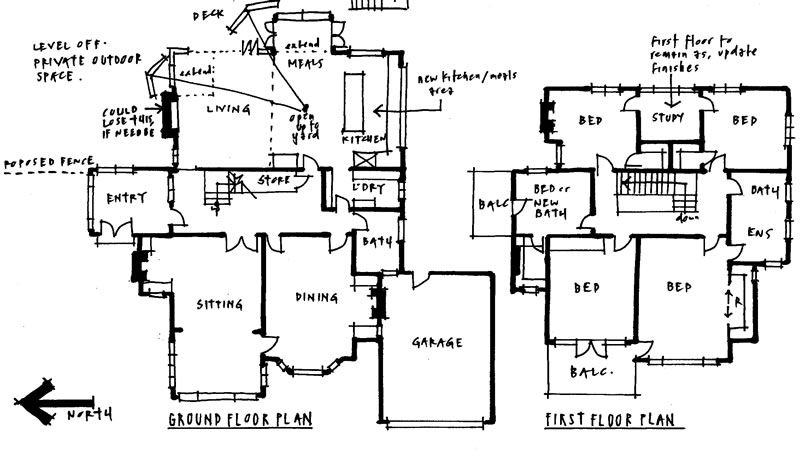24 June 2017

Completed homes in good suburbs continue to sell well, as this auction in Vickery Street Malvern East demonstrated. Seven bidders fought it out for this home, which sold under the hammer for $3.6m. (James Tomlinson and Rae Tomlinson, Marshall White).
Mid-year is a good chance to pause and take stock of the Melbourne property market’s performance so far. There is no doubt the market has performed strongly this year, particularly for good properties, ie well-renovated period homes, striking modern homes or premium land parcels.
For less than perfect offerings or those with issues, the gap between buyers and sellers has been widening recently, with a lot more properties left on the market for private sale after a failed auction than has been the case in previous months.
Winter is not traditionally a strong selling season in Melbourne, as colder weather and darker days means properties do not present in their best light. Many eyes are now on August and September auction selling campaigns.
While traditional residential suburbs (eg Camberwell, Brighton) had limited offerings, the inner-city suburbs like Carlton / Fitzroy recorded some good results, as you will see below.
Some sales of note:
99 Newry Street Fitzroy North (Luke Sacco/Katie Long, Nelson Alexander) – blue-chip single-level two-bedroom Victorian worker’s cottage, north-facing rear. Quoted $1.25m-$1.35m and sold strongly under the hammer for $1.68m.
570 Canning Street Carlton North (Jason Sharpe/Vicki Sunbul, Woodards) – bought before auction for $2.4m. Buyers need to be aware that a good property may draw big interest before the scheduled auction date and keen buyers won’t necessarily wait until auction day to buy. But, if you are planning on pursuing a buy-before-auction strategy, make sure you’re got a solid understanding of value.
80-82 Gipps Street East Melbourne (Nicholas West/Charlie Barham, Nelson Alexander) –block of flats in an iconic location, sold for an undisclosed price over $5m – over $500K over reserve. We have seen this type of thing before in East Melbourne and it’s hard to go too far wrong if you do your homework.
23 Broomfield Road Hawthorn East (George Bushby/Ryan Keys, Jellis Craig) – single-fronted Victorian, renovated – sold under the hammer for $2.31m (last sold in 2012 for $1.575m). Single-fronters continue to out-perform double-fronters …
‘Land’ Sales:
20 Britten Street Glen Iris (Will Bennison/Lachie Fraser-Smith, Jellis Craig) 858sqm, solid home, south rear – $2.862m or close to $3,335/sqm.
9 Baird Street Brighton East (Stephen Smith/Ben Veith, Marshall White), 786sqm, dated ‘80s house, sold for $2.72m or $3,460/sqm.
1032 Drummond Street Carlton North (Nicholas West/Charlie Barham, Nelson Alexander) – 879m2 or around $6,000/sqm.
Off-markets
- Land in Hampton, close to Hampton Street – $1.9m
- Dated cottage in Port Melbourne – $2-2.2m
- Family home in Balwyn North with great views – $2.8m
- Renovated Edwardian home in Alphington on good land – $2.2m
- Architect-designed home in Beaumaris – $2.2m
- Single-level timber home in Armadale – $2.2m
New quoting law analysis
Almost two months after the introduction of the new Victorian quoting laws, what sort of impact are we seeing? At WoledgeHatt, we physically inspected dozens of properties in our area of specialisation – $1.5m-plus in Boroondara, Bayside and Stonnington councils – taking note of the Statement of Information (SOI) quotes and comparables, as well as the eventual selling price of the properties. As a result, we have seen a reasonable shift in numbers (taking out outlier results for properties that sold vastly above reserve).
For May sales, where properties were still signed up under the ‘old system’, we saw sale prices on average 4.8% over the top of the quote range. Nearly two-thirds of properties were quoted below the eventual sales price.
For June sales, where the market has started to settle into the new laws, we have seen a lessening in this number, with properties selling on average 2.3% over the top of the quote price. Nearly half of all properties are now selling within the quote range.
While it will take a few more months for the backlog of properties signed up before the new quotation laws came into effect to clear through the system, if this trend continues, it looks as though quotations are coming more into line with buyers’ willingness to pay.
From general discussions with agents throughout this time, there are probably a few teething issues to continue to work through in regards to the selection of comparable properties. Depending on the property and the area, can the 2km and six-month limit at times be too restrictive and eliminate better-suited comparables, or is it too liberal and permits the inclusion of properties that are realistically not a comparison?
As a buyer, has this made things better or easier? Perhaps. Yet understanding the true value of an individual property, given its scarcity or place in the market, is still key to paying the right price for a property. More importantly, what the buyer wants to get out of the property should influence what they are prepared to pay for it, more so than the range that it is being quoted at.
Renovating – as a buyer/owner are you under-developing?
In recent years, as you may have noticed, there has been a huge amount of development going on around Melbourne and, in certain areas, councils are really encouraging this development. If you are considering renovating, it pays to keep this in mind when planning. Some call it ‘over-capitalising’, some call it ‘under-developing’, but the result is the same: the real value of your property could be in the dirt bounded by the fences, not the house itself.
Having architectural experience, we are often asked how to renovate homes and we welcome these conversations. A common theme lately has been with people wanting to undertake extensions to their existing homes, or build new on their land. Here are a couple of issues that have come to light:
- While the home may have intrinsic period quality, it may not be protected by a heritage overlay, or it could be subject to new zoning overlays that mean higher height levels are permitted. This of course encourages development. If you are able to build up to 11m metres (say) and don’t choose to (which is fair enough), your neighbours may do so and this could adversely affect your amenity and capital growth (ie your renovation costs mean nought in the end, as the true value of the property is in the land).
- Alternatively, the home may be in a Heritage Overlay area, or in a more restrictive Neighbourhood Residential Zone. Getting the right balance of old and new is critical, and you need to be very careful when planning.
These two issues can have a big impact on the re-sale or property in Melbourne. You may love your house and area and see yourself there for the next 20 years, in which case whatever money you sink into your renovation will be worth the cost. But if you are thinking of selling your house within 5-10 years, don’t expect to get the money back.
You should also plan a sympathetic renovation that is in line with the overwhelming wants and needs of buyers in that area. Spending $1 million on a renovation in Malvern where there is a lot of development and many newer properties are being built could be a waste of money. You may be better to sell and move to the Gascoigne Estate where you will be protected by heritage overlays. Similarly, building a modest cottage that’s more suited to the inner north in a leafy eastern suburb where dual occupancies or larger family homes are more in demand is also not a worthwhile investment.
More than ever, it pays to get the advice of a good architect, town planner and experienced selling agent before making any of these key decisions.
Auction Spotlight:
9 Alleyne Avenue Armadale

Andrew Hayne conducts an entertaining auction in front of around 200 people in Alleyne Avenue, Armadale.
This was a landmark 2017 auction, and a very good crowd attended. Why was it landmark? Well, the home was a beauty – cleverly designed, well renovated, enjoying an ideal north-facing rear aspect, and very conveniently located to most things great in Armadale. The property was also very well marketed and presented. There was not a stone left unturned here by the vendor. While there was were clearly a lot of interested parties within the quoted price range, a vendor bid was still needed to get this auction kicked off and Andrew Hayne did that at $4.4m. Not long after, the first bidder entered the fray at $5m, which clearly made a strong statement. A fight was on not long after between the original bidder and one other, and the property sold under the hammer for $5.925m, almost $1m over the announced reserve. A lot of people will be surprised by this result but it just shows that buyers in this market will pay a premium for quality offerings, especially those they can move straight into. Expect to see plenty of renovation projects in this area in the coming months … the formula and process isn’t that easy though.
44 McKinley Ave Malvern

Andrew McCann and the Jellis Craig team had the sun shining down on them at the auction of this property in Malvern.
This home is an example of an unrenovated version of double-fronted period properties in the area that have recently sold for between $5-6m. Well positioned to amenities and transport, the property currently offers off-street parking, but may not allow for future garaging.
With most of the crowd spread along the opposite side of the street, as well as some key bidders on the property side, Andrew McCann from Jellis Craig needed to make his voice carry far and wide. A swift opening bid of $2.75m started proceedings and bidding from a number of parties easily brought the property onto the market at $3.01m. By the time the property was knocked down for $3.19m, five bidders had put their hand up for the property and the chance to transform this home into the period beauty it could be.
2C Kerferd Street, Hampton

Two bidders bid strongly for this property, which showed the demand for ‘position’ first. (Kate Strickland/Robin Parker, Marshall White).
‘Hampton’s style’ in Hampton. This new home was very well located to the Hampton shops, station and beach, offering four good bedrooms (the main downstairs) and multiple living options, including a separate room off the back of the garage. On a ‘battleaxe’ block, the home had no street frontage and was accessed via a stony laneway shared with the dwelling in front.
Two bidders bid strongly in $50,000 rises from the initial vendor bid from auctioneer Robin Parker of $2.8m. With little time to pause, Kate Strickland ran inside to consult with the vendors before returning to confirm the property ‘on the market’, with the eventual sale price settling at $3.15m.
This sale supports the increasing demand for ‘position’ first. With limited choices available for buyers wanting family homes, the position encouraged buyers to overlook any potential or future negativity brought about by the lack of street frontage, lower ceilings and limited windows in the family room.





